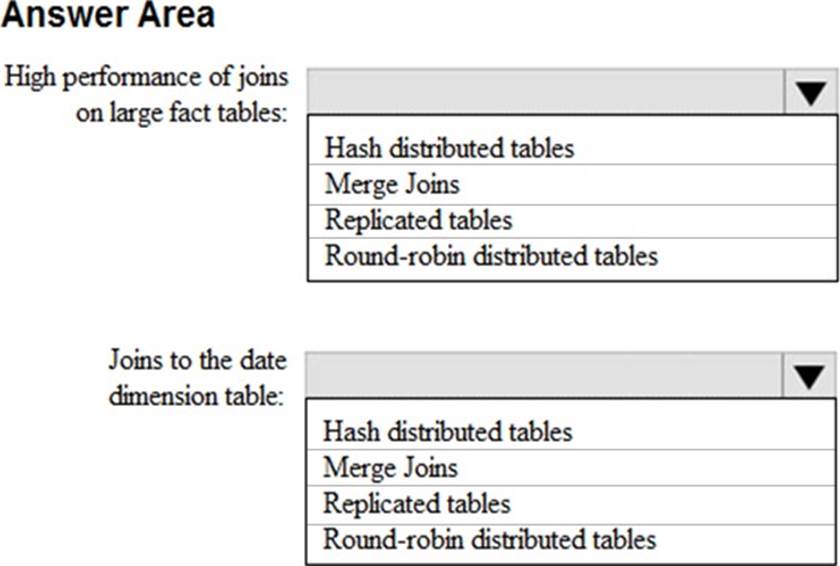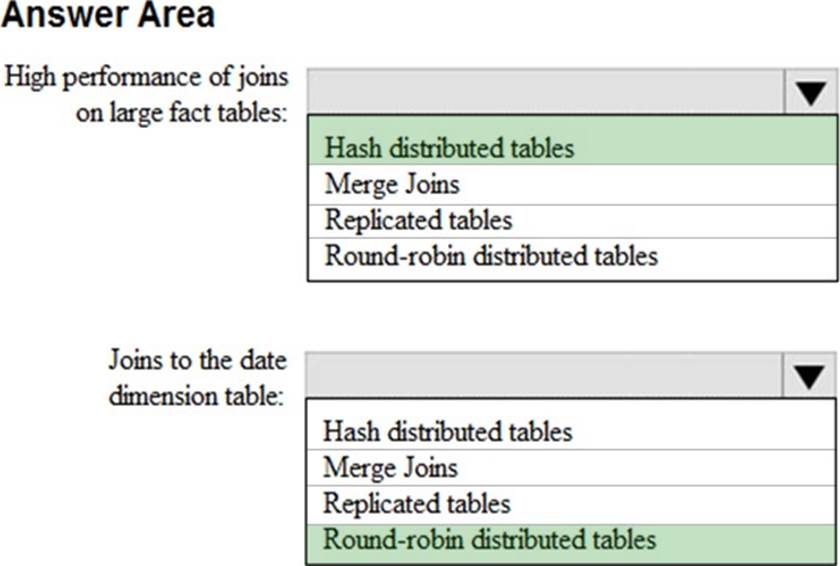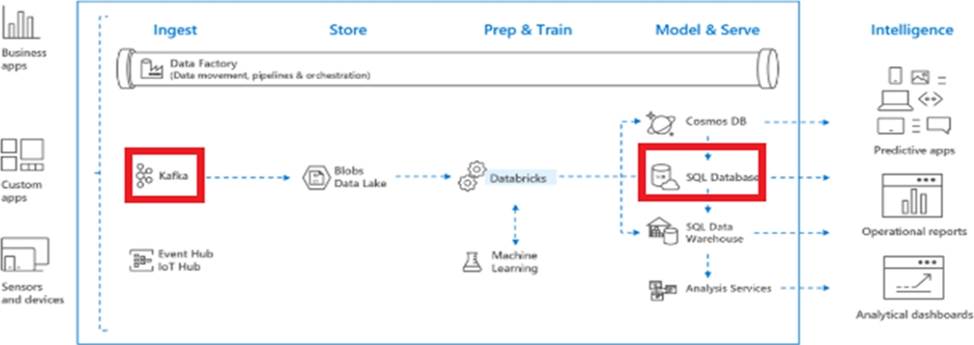Microsoft DP-201 Designing an Azure Data Solution Online Training
Microsoft DP-201 Online Training
The questions for DP-201 were last updated at Dec 15,2025.
- Exam Code: DP-201
- Exam Name: Designing an Azure Data Solution
- Certification Provider: Microsoft
- Latest update: Dec 15,2025
You need to design a solution that meets the business requirements of Health Insights.
What should you include in the recommendation?
- A . Azure Cosmos DB that uses the Gremlin
- B . Azure Data Factory
- C . Azure Cosmos DB that uses the SQL API
- D . Azure Databricks
You need to recommend a solution to quickly identify all the columns in Health Review that contain sensitive health data.
What should you include in the recommendation?
- A . classifications
- B . data masking
- C . SQL Server auditing
- D . Azure tags
What should you recommend as a batch processing solution for Health Interface?
- A . Azure CycleCloud
- B . Azure Stream Analytics
- C . Azure Data Factory
- D . Azure Databricks
HOTSPOT
You need to design the storage for the Health Insights data platform.
Which types of tables should you include in the design? To answer, select the appropriate options in the answer area. NOTE: Each correct selection is worth one point.

Topic 5, Data Engineer for Trey Research
Overview
You are a data engineer for Trey Research. The company is close to completing a joint project with the government to build smart highways infrastructure across North America. This involves the placement of sensors and cameras to measure traffic flow, car speed, and vehicle details.
You have been asked to design a cloud solution that will meet the business and technical requirements of the smart highway.
Solution components
Telemetry Capture
The telemetry capture system records each time a vehicle passes in front of a sensor.
The sensors run on a custom embedded operating system and record the following telemetry data:
– Time
– Location in latitude and longitude
– Speed in kilometers per hour (kmph)
– Length of vehicle in meters
Visual Monitoring
The visual monitoring system is a network of approximately 1,000 cameras placed near highways that capture images of vehicle traffic every 2 seconds. The cameras record high resolution images. Each image is approximately 3 MB in size.
Requirements: Business
The company identifies the following business requirements:
– External vendors must be able to perform custom analysis of data using machine learning technologies.
– You must display a dashboard on the operations status page that displays the following metrics: telemetry, volume, and processing latency.
– Traffic data must be made available to the Government Planning Department for the purpose of modeling changes to the highway system. The traffic data will be used in conjunction with other data such as information about events such as sporting events, weather conditions, and population statistics. External data used during the modeling is stored in on-premises SQL Server 2016 databases and CSV files stored in an Azure Data Lake Storage Gen2 storage account.
– Information about vehicles that have been detected as going over the speed limit during the last 30 minutes must be available to law enforcement officers. Several law enforcement organizations may respond to speeding vehicles.
– The solution must allow for searches of vehicle images by license plate to support law enforcement investigations. Searches must be able to be performed using a query language and must support fuzzy searches to compensate for license plate detection errors.
Requirements: Security
The solution must meet the following security requirements:
– External vendors must not have direct access to sensor data or images.
– Images produced by the vehicle monitoring solution must be deleted after one month. You must minimize costs associated with deleting images from the data store.
– Unauthorized usage of data must be detected in real time. Unauthorized usage is determined by looking for unusual usage patterns.
– All changes to Azure resources used by the solution must be recorded and stored. Data must be provided to the security team for incident response purposes.
Requirements: Sensor data
You must write all telemetry data to the closest Azure region. The sensors used for the telemetry capture system have a small amount of memory available and so must write data as quickly as possible to avoid losing telemetry data.
You need to design the storage for the telemetry capture system.
What storage solution should you use in the design?
- A . Azure SQL Data Warehouse
- B . Azure Databricks
- C . Azure Cosmos DB
You need to design the storage for the visual monitoring system.
Which storage solution should you recommend?
- A . Azure Blob storage
- B . Azure Table storage
- C . Azure SQL database
- D . Azure Media Services
You need to design the unauthorized data usage detection system.
What Azure service should you include in the design?
- A . Azure Databricks
- B . Azure SQL Data Warehouse
- C . Azure Analysis Services
- D . Azure Data Factory
DRAG DROP
You need to design the system for notifying law enforcement officers about speeding vehicles.
How should you design the pipeline? To answer, drag the appropriate services to the correct locations. Each service may be used once, more than once, or not at all. You may need to drag the split bar between panes or scroll to view content. NOTE: Each correct selection is worth one point.

You need to design the solution for the government planning department.
Which services should you include in the design?
- A . Azure SQL Data Warehouse and Elastic Queries
- B . Azure SQL Database and Polybase
- C . Azure SQL Data Warehouse and Polybase
- D . Azure SQL Database and Elastic Queries
Topic 6, Litware Case
Case study
This is a case study. Case studies are not timed separately. You can use as much exam time as you would like to complete each case. However, there may be additional case studies and sections on this exam. You must manage your time to ensure that you are able to complete all questions included on this exam in the time provided.
To answer the questions included in a case study, you will need to reference information that is provided in the case study. Case studies might contain exhibits and other resources that provide more information about the scenario that is described in the case study. Each question is independent of the other questions in this case study.
At the end of this case study, a review screen will appear. This screen allows you to review your answers and to make changes before you move to the next section of the exam. After you begin a new section, you cannot return to this section.
To start the case study
To display the first question in this case study, click the Next button. Use the buttons in the left pane to explore the content of the case study before you answer the questions. Clicking these buttons displays information such as business requirements, existing environment, and problem statements. If the case study has an All Information tab, note that the information displayed is identical to the information displayed on the subsequent tabs. When you are ready to answer a question, click the Question button to return to the question.
Overview
Litware, Inc. owns and operates 300 convenience stores across the US. The company sells a variety of packaged foods and drinks, as well as a variety of prepared foods, such as sandwiches and pizzas.
Litware has a loyalty club whereby members can get daily discounts on specific items by providing their membership number at checkout.
Litware employs business analysts who prefer to analyze data by using Microsoft Power BI, and data scientists who prefer analyzing data in Azure Databricks notebooks.
Requirements. Business Goals
Litware wants to create a new analytics environment in Azure to meet the following requirements:
– See inventory levels across the stores. Data must be updated as close to real time as possible.
– Execute ad hoc analytical queries on historical data to identify whether the loyalty club discounts increase sales of the discounted products.
– Every four hours, notify store employees about how many prepared food items to produce based on historical demand from the sales data.
Requirements. Technical Requirements
Litware identifies the following technical requirements:
– Minimize the number of different Azure services needed to achieve the business goals
– Use platform as a service (PaaS) offerings whenever possible and avoid having to provision virtual machines that must be managed by Litware.
– Ensure that the analytical data store is accessible only to the company’s on-premises network and Azure services.
– Use Azure Active Directory (Azure AD) authentication whenever possible.
– Use the principle of least privilege when designing security.
– Stage inventory data in Azure Data Lake Storage Gen2 before loading the data into the analytical data store. Litware wants to remove transient data from Data Lake Storage once the data is no longer in use. Files that have a modified date that is older than 14 days must be removed.
– Limit the business analysts’ access to customer contact information, such as phone numbers, because this type of data is not analytically relevant.
– Ensure that you can quickly restore a copy of the analytical data store within one hour in the event of corruption or accidental deletion.
Requirements. Planned Environment
Litware plans to implement the following environment:
– The application development team will create an Azure event hub to receive real-time sales data, including store number, date, time, product ID, customer loyalty number, price, and discount amount, from the point of sale (POS) system and output the data to data storage in Azure.
– Customer data, including name, contact information, and loyalty number, comes from Salesforce and can be imported into Azure once every eight hours. Row modified dates are not trusted in the source table.
– Product data, including product ID, name, and category, comes from Salesforce and can be imported into Azure once every eight hours. Row modified dates are not trusted in the source table.
– Daily inventory data comes from a Microsoft SQL server located on a private network.
– Litware currently has 5 TB of historical sales data and 100 GB of customer data. The company expects approximately 100 GB of new data per month for the next year.
– Litware will build a custom application named FoodPrep to provide store employees with the calculation results of how many prepared food items to produce every four hours.
– Litware does not plan to implement Azure ExpressRoute or a VPN between the on-premises network and Azure.
What should you do to improve high availability of the real-time data processing solution?
- A . Deploy identical Azure Stream Analytics jobs to paired regions in Azure.
- B . Deploy a High Concurrency Databricks cluster.
- C . Deploy an Azure Stream Analytics job and use an Azure Automation runbook to check the status of the job and to start the job if it stops.
- D . Set Data Lake Storage to use geo-redundant storage (GRS).
Latest DP-201 Dumps Valid Version with 208 Q&As
Latest And Valid Q&A | Instant Download | Once Fail, Full Refund




